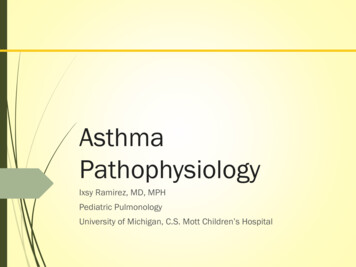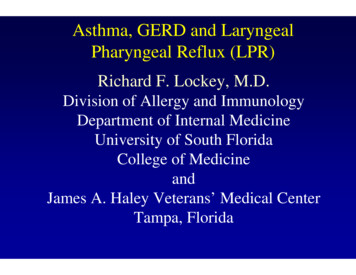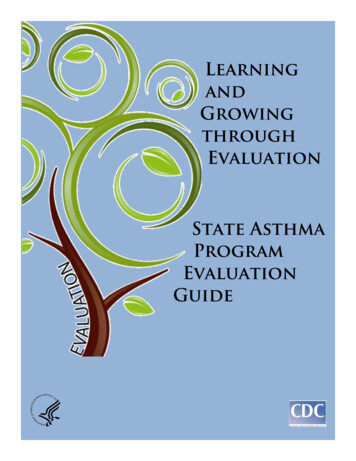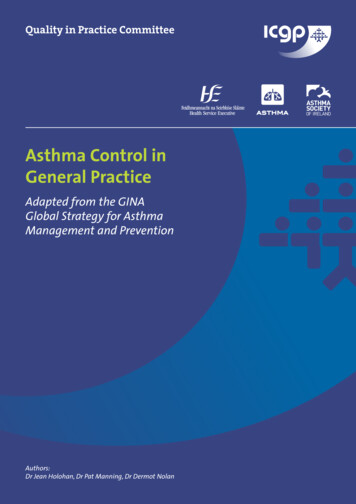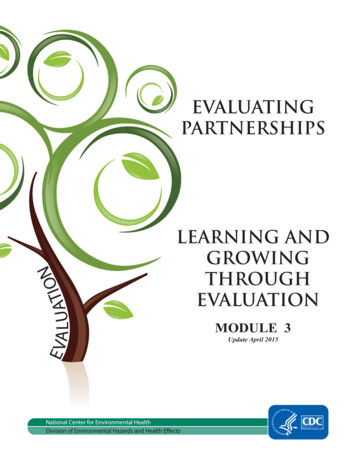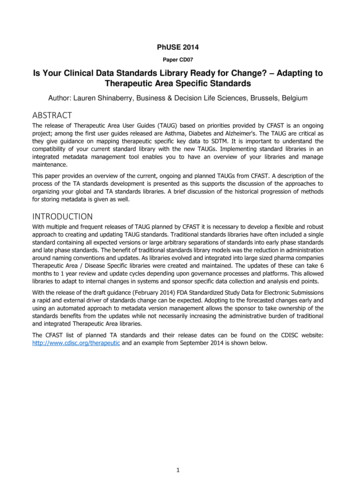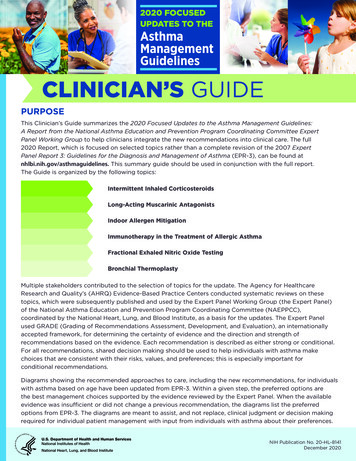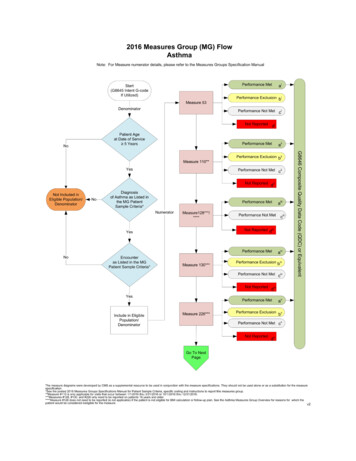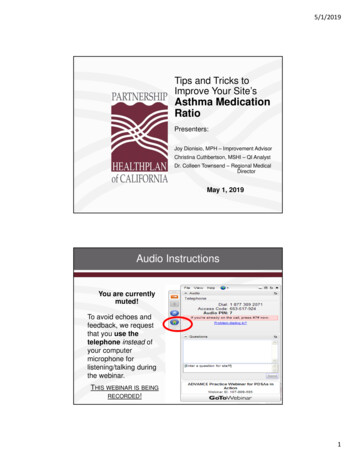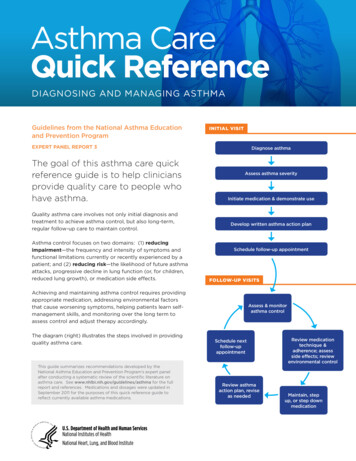
Transcription
Asthma CareQuick ReferenceDIAGNOSING AND MANAGING ASTHMAGuidelines from the National Asthma Educationand Prevention ProgramINITIAL VISITEXPERT PANEL REPORT 3The goal of this asthma care quickreference guide is to help cliniciansprovide quality care to people whohave asthma.Quality asthma care involves not only initial diagnosis andtreatment to achieve asthma control, but also long-term,regular follow-up care to maintain control.Asthma control focuses on two domains: (1) reducingimpairment—the frequency and intensity of symptoms andfunctional limitations currently or recently experienced by apatient; and (2) reducing risk—the likelihood of future asthmaattacks, progressive decline in lung function (or, for children,reduced lung growth), or medication side effects.Diagnose asthmaAssess asthma severityInitiate medication & demonstrate useDevelop written asthma action planSchedule follow-up appointmentFOLLOW-UP VISITSAchieving and maintaining asthma control requires providingappropriate medication, addressing environmental factorsthat cause worsening symptoms, helping patients learn selfmanagement skills, and monitoring over the long term toassess control and adjust therapy accordingly.The diagram (right) illustrates the steps involved in providingquality asthma care.This guide summarizes recommendations developed by theNational Asthma Education and Prevention Program’s expert panelafter conducting a systematic review of the scientific literature onasthma care. See www.nhlbi.nih.gov/guidelines/asthma for the fullreport and references. Medications and dosages were updated inSeptember 2011 for the purposes of this quick reference guide toreflect currently available asthma medications.Assess & monitorasthma controlSchedule nextfollow-upappointmentReview asthmaaction plan, reviseas neededReview medicationtechnique &adherence; assessside effects; reviewenvironmental controlMaintain, stepup, or step downmedication
2Asthma Care Quick ReferenceKEY CLINICAL ACTIVITIES FOR QUALITY ASTHMA CARE(See complete table in Expert Panel Report 3: Guidelines for the Diagnosis and Management of Asthma [EPR-3])Clinical IssueKey Clinical Activities and Action StepsASTHMA DIAGNOSISEstablish asthma diagnosis. Determine that symptoms of recurrent airway obstruction are present, based on historyand exam. History of cough, recurrent wheezing, recurrent difficulty breathing, recurrentchest tightness Symptoms occur or worsen at night or with exercise, viral infection, exposure to allergensand irritants, changes in weather, hard laughing or crying, stress, or other factors In all patients 5 years of age, use spirometry to determine that airway obstruction is atleast partially reversible. Consider other causes of obstruction.LONG-TERM ASTHMA MANAGEMENTGOAL:Asthma ControlReduce Impairment Prevent chronic symptoms. Require infrequent use of short-acting beta2-agonist (SABA). Maintain (near) normal lung function and normal activity levels.Reduce Risk Assessmentand MonitoringPrevent exacerbations.Minimize need for emergency care, hospitalization.Prevent loss of lung function (or, for children, prevent reduced lung growth).Minimize adverse effects of therapy.INITIAL VISIT: Assess asthma severity to initiate treatment (see page 5).FOLLOW-UP VISITS: Assess asthma control to determine if therapy should be adjusted(see page 6). Assess at each visit: asthma control, proper medication technique, written asthma actionplan, patient adherence, patient concerns. Obtain lung function measures by spirometry at least every 1–2 years; more frequently forasthma that is not well controlled. Determine if therapy should be adjusted: Maintain treatment; step up, if needed; stepdown, if possible.Schedule follow-up care. Asthma is highly variable over time. See patients: Every 2–6 weeks while gaining control Every 1–6 months to monitor control Every 3 months if step down in therapy is anticipatedUse ofMedicationsSelect medication and delivery devices that meet patient’s needs and circumstances. Use stepwise approach to identify appropriate treatment options (see page 7). Inhaled corticosteroids (ICSs) are the most effective long-term control therapy. When choosing treatment, consider domain of relevance to the patient (risk, impairment,or both), patient’s history of response to the medication, and willingness and ability to usethe medication.Review medications, technique, and adherence at each follow-up visit.
Asthma Care Quick ReferenceKEY CLINICAL ACTIVITIES FOR QUALITY ASTHMA CAREClinical IssueKey Clinical Activities and Action StepsPatientEducation forSelf-ManagementTeach patients how to manage their asthma.(continued) Teach and reinforce at each visit: Self-monitoring to assess level of asthma control and recognize signs of worseningasthma (either symptom or peak flow monitoring) Taking medication correctly (inhaler technique, use of devices, understandingdifference between long-term control and quick-relief medications)- Long-term control medications (such as inhaled corticosteroids, which reduceinflammation) prevent symptoms. Should be taken daily; will not give quick relief.- Quick-relief medications (short-acting beta2-agonists or SABAs) relax airwaymuscles to provide fast relief of symptoms. Will not provide long-term asthmacontrol. If used 2 days/week (except as needed for exercise-induced asthma),the patient may need to start or increase long-term control medications. Avoiding environmental factors that worsen asthmaDevelop a written asthma action plan in partnership with patient/family (sample planavailable at www.nhlbi.nih.gov/health/public/lung/asthma/asthma actplan.pdf). Agree on treatment goals. Teach patients how to use the asthma action plan to: Take daily actions to control asthma Adjust medications in response to worsening asthma Seek medical care as appropriate Encourage adherence to the asthma action plan. Choose treatment that achieves outcomes and addresses preferences important tothe patient/family. Review at each visit any success in achieving control, any concerns about treatment,any difficulties following the plan, and any possible actions to improve adherence. Provide encouragement and praise, which builds patient confidence. Encourage familyinvolvement to provide support.Integrate education into all points of care involving interactions with patients. Include members of all health care disciplines (e.g., physicians, pharmacists, nurses, respiratorytherapists, and asthma educators) in providing and reinforcing education at all points of care.Control ofEnvironmentalFactors andComorbidConditionsRecommend ways to control exposures to allergens, irritants, and pollutants that makeasthma worse. Determine exposures, history of symptoms after exposures, and sensitivities.(In patients with persistent asthma, use skin or in vitro testing to assess sensitivity toperennial indoor allergens to which the patient is exposed.) Recommend multifaceted approaches to control exposures to which the patient issensitive; single steps alone are generally ineffective. Advise all asthma patients and all pregnant women to avoid exposure to tobacco smoke. Consider allergen immunotherapy by trained personnel for patients with persistentasthma when there is a clear connection between symptoms and exposure to anallergen to which the patient is sensitive.Treat comorbid conditions. Consider allergic bronchopulmonary aspergillosis, gastroesophageal reflux, obesity,obstructive sleep apnea, rhinitis and sinusitis, and stress or depression. Treatment ofthese conditions may improve asthma control. Consider inactivated flu vaccine for all patients 6 months of age.3
4Asthma Care Quick ReferenceASTHMA CARE FOR SPECIAL CIRCUMSTANCESClinical IssueKey Clinical Activities and Action StepsExercise-InducedBronchospasmPrevent EIB.* Physical activity should be encouraged. For most patients, EIB should not limitparticipation in any activity they choose. Teach patients to take treatment before exercise. SABAs* will prevent EIB in most patients;LTRAs,* cromolyn, or LABAs* also are protective. Frequent or chronic use of LABA toprevent EIB is discouraged, as it may disguise poorly controlled persistent asthma. Consider long-term control medication. EIB often is a marker of inadequate asthma controland responds well to regular anti-inflammatory therapy. Encourage a warm-up period or mask or scarf over the mouth for cold-induced EIB.PregnancyMaintain asthma control through pregnancy. Check asthma control at all prenatal visits. Asthma can worsen or improve duringpregnancy; adjust medications as needed. Treating asthma with medications is safer for the mother and fetus than having poorlycontrolled asthma. Maintaining lung function is important to ensure oxygen supply to the fetus. ICSs* are the preferred long-term control medication. Remind patients to avoid exposure to tobacco smoke.MANAGING EXACERBATIONSClinical IssueKey Clinical Activities and Action StepsHome CareDevelop a written asthma action plan (see Patient Education for Self-Management, page 3).Teach patients how to: Recognize early signs, symptoms, and PEF* measures that indicate worsening asthma. Adjust medications (increase SABA* and, in some cases, add oral systemic corticosteroids)and remove or withdraw from environmental factors contributing to the exacerbation. Monitor response. Seek medical care if there is serious deterioration or lack of response to treatment.Give specific instructions on who and when to call.Urgent orEmergency CareAssess severity by lung function measures (for ages 5 years), physical examination, andsigns and symptoms.Treat to relieve hypoxemia and airflow obstruction; reduce airway inflammation. Use supplemental oxygen as appropriate to correct hypoxemia. Treat with repetitive or continuous SABA,* with the addition of inhaled ipratropiumbromide in severe exacerbations. Give oral systemic corticosteroids in moderate or severe exacerbations or for patients whofail to respond promptly and completely to SABA. Consider adjunctive treatments, such as intravenous magnesium sulfate or heliox, in severeexacerbations unresponsive to treatment.Monitor response with repeat assessment of lung function measures, physicalexamination, and signs and symptoms, and, in emergency department, pulse oximetry.Discharge with medication and patient education: Medications: SABA, oral systemic corticosteroids; consider starting ICS* Referral to follow-up care Asthma discharge plan Review of inhaler technique and, whenever possible, environmental control measures*Abbreviations:EIB, exercise-induced bronchospasm; ICS, inhaled corticosteroid; LABA, long-acting beta2-agonist; LTRA, leukotriene receptorantagonist; PEF, peak expiratory flow; SABA, short-acting beta2-agonist.
Asthma exacerbationsrequiring oral systemiccorticosteroids‡ FEV1 /FVC FEV1 (% predicted)Lung functionInterference withnormal activitySABA use forsymptom control(not to prevent EIB )Nighttime awakeningsSymptomsComponents ofSeverityNotapplicable0Ages0–4 yearsAges 12 yearsNormal† 85%Ages5–11 yearsMildAges 12 years 2 exacerb.in 6 months,or wheezing 4x peryear lasting 1 dayAND riskfactors forpersistentasthmaNotapplicable 2 days/weekbut not daily1–2x/monthNormal† 80%Notapplicable3–4x/monthAges0–4 yearsAges 12 years75–80%60–80%Some limitationDailyReduced 5%†60–80% 1x/week but not nightlyDailyAges5–11 yearsModerate 2/yearStep 1 75% 60%Extremely limitedStep 3Step 3Step 3medium-doseICS optionor Step 4Consider short course of oral systemic corticosteroids.Step 3medium-doseICS optionFor children 0–4 years old, if no clear benefit is observed in 4–6 weeks, consider adjusting therapy or alternate diagnoses.In 2–6 weeks, depending on severity, assess level of asthma control achieved and adjust therapy as needed.Step 2Step 3Relative annual risk of exacerbations may be related to FEV1 .Ages 12 yearsindicate greater underlying disease severity. For treatment purposes, patients with 2 exacerbations may be considered to have persistent asthma, even in the absence of impairment levels consistent with persistent asthma.† Normal FEV1 /FVC by age: 8–19 years, 85%; 20–39 years, 80%; 40–59 years, 75%; 60–80 years, 70%.‡ Data are insufficient to link frequencies of exacerbations with different levels of asthma severity. Generally, more frequent and intense exacerbations (e.g., requiring urgent care, hospital or intensive care admission, and/or oral corticosteroids)Step 4or 5Reduced 5%† 60%Often 7x/weekThroughout the dayAges5–11 yearsSevereSeveral times per dayNotapplicable 1x/weekAges0–4 yearsGenerally, more frequent and intense events indicate greater severity.Generally, more frequent and intense events indicate greater severity. 80% 80%Minor limitation 2 days/week butnot daily and not morethan once on any day3–4x/month 2 days/week but not dailyAges0–4 yearsPersistentConsider severity and interval since last asthma exacerbation. Frequency and severity may fluctuate over time for patients in any severity category.0–1/year 80%Normal FEV1betweenexacerbations 80%Normal FEV1betweenexacerbationsNone 2 days/week 2x/month 2 days/weekAges5–11 yearsIntermittentAbbreviations: EIB, exercise-induced bronchospam; FEV1 , forced expiratory volume in 1 second; FVC, forced vital capacity; ICS, inhaled corticosteroid; SABA, short-acting beta2-agonist.The stepwise approach is meantto help, not replace, the clinicaldecisionmaking needed to meetindividual patient needs.(See “Stepwise Approach forManaging Asthma Long Term,”page 7)Recommended Step forInitiating TherapyRiskImpairmentLevel of severity (Columns 2–5) is determined by events listed in Column 1 for both impairment (frequency and intensity of symptoms and functional limitations) and risk (ofexacerbations). Assess impairment by patient’s or caregiver’s recall of events during the previous 2–4 weeks; assess risk over the last year. Recommendations for
INITIAL VISIT: CLASSIFYING ASTHMA SEVERITY AND INITIATING THERAPY (in patients who are not currently taking long-term control medications) Level of severity (Columns 2–5) is determined by events listed in Column 1 for both impairment (frequency and intensity of symptoms and functional limitations) and risk (of exacerbations). Assess impairment by patient’s or caregiver’s recall of events during the File Size: 858KBPage Count: 12

